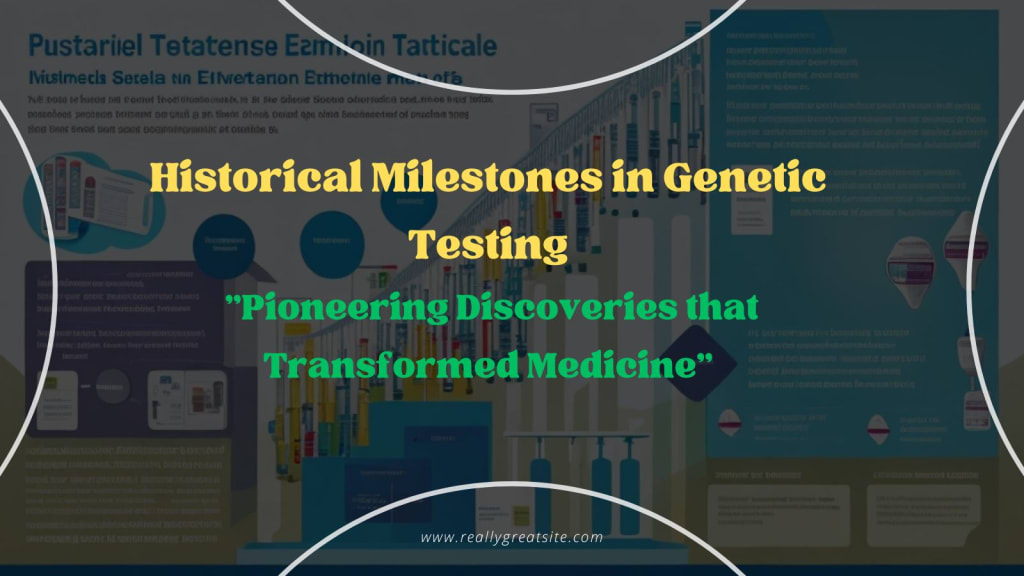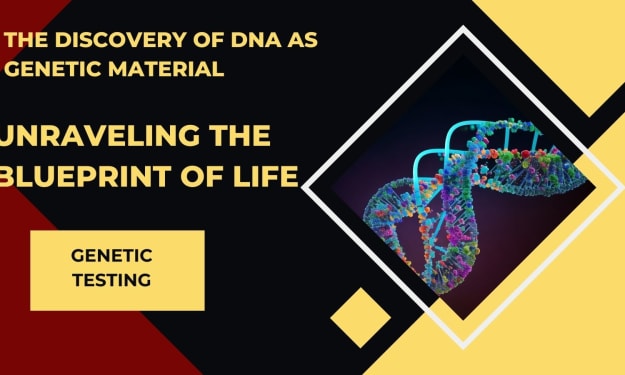Historical Milestones in Genetic Testing
Pioneering Discoveries that Transformed Medicine

Introduction
Genetic testing has upset the field of medicine, providing us with invaluable insights into our genetic cosmetics and inclinations to certain diseases. Throughout the long term, there have been critical historical milestones in genetic testing that have made ready for headways in personalized medicine and our understanding of genetic problems. In this article, we will investigate these milestones and the effect they have had on clinical science.
The Revelation of DNA Structure by James Watson and Francis Kink
In 1953, James Watson and Francis Cramp unwound the structure of DNA, the atom answerable for carrying genetic information. Building upon the examination of Rosalind Franklin, Watson, and Kink's groundbreaking work uncovered the twofold helix structure of DNA. This disclosure gave a pivotal establishment to our understanding of genetics and shaped the reason for the resulting progress in genetic testing.
The DNA structure comprises two intertwined strands, with the substance bases adenine (A), thymine (T), guanine (G), and cytosine (C) forming the genetic code. This cut cutting-edge powered researchers to concentrate on how qualities are stored, recreated, and passed starting with one generation and then onto the next.
Polymerase Chain Reaction (PCR) Strategy by Kary Mullis
Kary Mullis fostered the polymerase chain reaction (PCR) procedure in 1983, a strategy that changed genetic testing. PCR takes into consideration the intensification of specific DNA fragments, enabling researchers to study and examine genetic material all the more without any problem.
PCR works by over and over cycling the temperature of a DNA test, which makes the DNA denature and afterward reassemble, creating different duplicates of the objective DNA portion. This strategy has turned into a cornerstone in different genetic testing techniques, including DNA sequencing and genetic fingerprinting. PCR's speed and precision have enormously sped up the examination of genetic information, making it a fundamental tool in diagnosing genetic diseases and identifying genetic markers.
Human Genome Project
The Human Genome Project, sent off in 1990, was meant to guide and group the whole human genome. This aggressive international cooperation involved researchers from around the world and was finished in 2003. The project gave a complete blueprint of human qualities, facilitating the improvement of new genetic testing techniques and fueling discoveries connected with genetic diseases.
By deciphering the succession of all the DNA in the human genome, specialists gained insights into the capability of different qualities and their part in well-being and disease. The Human Genome Project established the groundwork for personalized medicine, enabling medical care experts to fit therapies to individuals in light of their remarkable genetic cosmetics.
Next-Generation Sequencing (NGS)
Next-generation sequencing, otherwise called high-throughput sequencing, arose during the 2000s and altered genetic testing. NGS methods empower the fast sequencing of a lot of DNA, allowing for more complete genetic investigation. This progression has fundamentally decreased the expense and time expected for genetic testing, making it more open for clinical and research purposes.
NGS innovations can at the same time group various DNA pieces, providing a complete perspective on an individual's genetic cosmetics. This approach has altered the ID of disease-causing transformations, the examination of genetic varieties, and the location of genetic inclinations. NGS has transformed the field of genetics, enabling scientists to concentrate on complex genetic problems with uncommon precision and proficiency.
Disclosure of Disease-Specific Genetic Markers
Researchers have made critical forward leaps in identifying disease-specific genetic markers. These markers are specific varieties in DNA groupings related to specific diseases. The disclosure of these markers has worked with the advancement of demonstrative tests that can recognize individuals in danger or impacted by certain genetic circumstances.
Genetic markers can act as indicators of disease presence, seriousness, or reaction to treatment. For instance, certain genetic markers are related to an increased
chance of developing bosom malignant growth or Alzheimer's disease. By identifying these markers through genetic testing, individuals can arrive at informed conclusions about their well-being and avoid potential risks or look for proper treatment.
Genetic Testing for Carrier Screening
Genetic testing has likewise assumed a pivotal part in carrier screening, which involves identifying individuals carrying genetic transformations that could be given to their youngsters. Carrier screening is especially significant for latent genetic problems, where the two guardians should convey the transformation for their youngster to be in danger.
Headways in genetic testing have empowered the improvement of exhaustive carrier screening boards that can identify a great many genetic transformations. This information permits couples to settle on informed decisions about family planning and look for genetic counseling if vital. By identifying potential dangers from the beginning, couples can find proactive ways to guarantee the well-being and prosperity of their future kids.
Pharmacogenomics and Personalized Medicine
Pharmacogenomics is a field that examines what an individual's genetic cosmetics means for their reaction to drugs. Genetic testing assumes a basic part in pharmacogenomics, allowing medical care experts to tailor therapy plans in view of a patient's genetic profile.
By analyzing specific genetic varieties, clinicians can determine how a patient is probably going to answer a specific drug. This information streamlines drug determination, measurements, and minimize unfriendly impacts. Pharmacogenomic testing is transforming the field of medicine by shifting towards personalized treatment procedures, enhancing patient results, and reducing the gamble of unfriendly medication reactions.
Direct-to-Consumer Genetic Testing
The appearance of direct-to-consumer genetic testing organizations, for example, 23andMe and AncestryDNA, has made genetic testing open to the overall population. These tests permit individuals to investigate their genetic lineage, uncover potential well-being dangers, and gain insights into their genetic characteristics.
While direct-to-consumer genetic testing gives important information, moving toward the outcomes with caution is fundamental. The interpretation of genetic information ought to be finished in discussion with medical services experts who can give precise and extensive direction in view of the individual's remarkable conditions.
Conclusion
The historical milestones in genetic testing have impelled the field of genetics forward, revolutionizing medicine and our understanding of human wellbeing. From the disclosure of DNA structure to the improvement of cutting-edge sequencing advances, genetic testing has prepared for personalized medicine, early disease location, and informed direction.
As innovation continues to progress, genetic testing will turn out to be increasingly integral to medical services, enabling individuals to make proactive strides toward disease anticipation and personalized therapies. Remain tuned as more examinations and discoveries unfurl, expanding our insight and improving the nature of medical services for generations to come.
About the Creator
Literary fusion
Welcome to literary fusion where art and literature intertwine to create a vibrant tapestry. I am [Abdullah Shabir], an artist and writer exploring self-expression through colors and carefully chosen words.






Comments
There are no comments for this story
Be the first to respond and start the conversation.